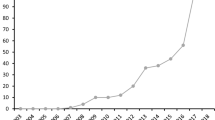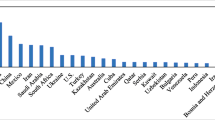Abstract
The vertical environmental reform in China has led to the change of environmental management system from territorial management model to vertical management model. This study uses the data of 263 prefecture-level cities in China to examine the effects of China’s vertical environmental reform on pollutant emissions, including industrial sulfur dioxide, wastewater emissions, and industrial fumes emissions. The findings demonstrate that vertical environmental reform resulted in a reduction in industrial sulfur dioxide, wastewater emissions, and industrial fumes emissions. And the governance effects is gradually enhanced with the passage of time, which are long-lasting effects. The above conclusions are still valid after a series of robust estimates including mitigating selection bias, placebo test, changing the dependent variables, and mitigating heterogeneous treatment effects. According to heterogeneity analysis, the vertical environmental reform has reduced the increase of pollutants caused by financial pressure and official associations, and treats border pollution problems more effectively. Under the decentralized governance system, the implementation of vertical environmental management helps to reduce local pollutant emissions. This conclusion provides the latest evidence from China for the academic debate on the advantages and disadvantages of territorial environmental management and vertical environmental management and also provides policy implications for the government’s environmental governance.








Similar content being viewed by others
Data availability
Some or all data, models, or codes generated or used during the study are available from the corresponding author upon request.
Notes
There has been the sub-city environmental protection administrative management system reform viewing in Shanxi Province since 2002.
An important reason for Shanxi Province’s implementation of sub-municipal vertical management reform in 2002 was the Han River water pollution incident in 2001, which sparked great concern in society as well as the central government.
The approach of Callaway and Sant’Anna (2021) is very similar to Sun and Abraham (2021), while Sun and Abraham (2021) use the last treated cohorts as controls (effectively treating these cohorts as never-treated) and Callaway and Sant’Anna (2021) use all not-yet-treated cohorts as controls. Because all provinces finally implemented VER, this paper uses the method of Callaway and Sant’Anna (2021).
Abbreviations
- SO2 :
-
Sulfur dioxide emissions
- EPBs:
-
Environmental protection bureaus
- VER:
-
Vertical environmental reform
- MEE:
-
Ministry of Ecology and Environment
- gdp:
-
Regional gross domestic product
- dens:
-
Population density
- ind:
-
Industry structure
- fisc:
-
Fiscal pressure
- fdi:
-
Foreign investment
- acc:
-
Number of environmental emergencies in the previous year
References
Agarwal S, Sing TF, Yang Y (2020) The impact of transboundary haze pollution on household utilities consumption. Energy Econ 85:104591
Aghion P, Tirole J (1997) Formal and real authority in organizations. J Polit Econ 105:37–83
Antweiler W, Copeland B, Taylor M (2001) Is free trade good for the environment. Am Econ Rev 91(4):877–908
Beck T, Ross L, Alexey L (2010) Big bad banks? The winners and losers from bank deregulation in the United States. J Fin 65(5):1637–1667
Besley T, Coate S (2003) Centralized versus decentralized provision of local public goods: a political economy approach. J Public Econ 87(12):2611–2637
Borck R, Schrauth P (2021) Population density and urban air quality. Reg Sci Urban Econ 86:103596
Brynard PA (2009) Mapping the factors that influence policy implementation. South African Association for Public Administration and Management. Retrieved from
Callaway B, Sant’Anna PHC, (2021) Difference-in-differences with multiple time periods. J Econ 225(2):200–230
Chen Y, Zhao L (2019) Exploring the relation between the industrial structure and the eco-environment based on an integrated approach: a case study of Beijing, China. Ecol Indic 103:83–93
Chen Z, Wang JN, Ma GX, Zhang YS (2013) China tackles the health effects of air pollution. Lancet 382(9909):1959–1960
Chen J, Wang B, Huang S, Song M (2020) The influence of increased population density in China on air pollution. Sci Total Environ 735:139456
de Chaisemartin C, D’Haultfœuille X (2020) Two-way fixed effects estimators with heterogeneous treatment effects. Am Econ Rev 110(9):2964–2996
Feng T, Chen X, Ma J, Sun Y, Du H, Yao Y, Mi Z (2023) Air pollution control or economic development? Empirical evidence from enterprises with production restrictions. J Environ Manage 336:117611
Golding WF (2011) Incentives for change: China’s cadre system applied to water quality. Pac Rim Law Policy J 20:399–428
Goodman-Bacon A (2021) Difference-in-differences with variation in treatment timing. J Econ 225(2):254–277
Grossman G, Krueger A (1995) Economic growth and the environment. Quart J Econ 2(110):353–377
Han C, Tian X (2022) Less pollution under a more centralized environmental system: evidence from vertical environmental reforms in China. Energy Econ 112:106–121
Han C, Sun X, Tian X (2021) Environmental centralizing and firm productivity: evidence from China’s vertical environmental reforms. Land Econ 97:723–744
Hua Y, Partridge M, Sun W (2023) Pollution effects of place-based policy: evidence from China’s development-zone program. J Reg Sci
Jia R, Nie H (2017) Decentralization, collusion, and coal mine deaths. Rev Econ Stat 99:105–118
Jin H, Liu W, Chen S (2023) Centralization and firm pollution emissions: evidence from City–county Merger in China. J Clean Prod 416:137964
Kostka G (2013) Environmental protection bureau leadership at the provincial level in China: examining diverging career backgrounds and appointment patterns. J Environ Planning Policy Manage 15(1):41–63
Lee LF, Yu J (2010) Estimation of spatial autoregressive panel data models with fixed effects. J Econ 154(2):165–185
Li R, Ramanathan R (2020) Can environmental investments benefit environmental performance? The moderating roles of institutional environment and foreign direct investment. Bus Strateg Environ 29(8):3385–3398
Li H, Zhou L (2005) Political turnover and economic performance: the incentive role of personnel control in China. J Public Econ 89:1743–1762
Li X, Yang X, Wei Q, Zhang B (2019) Authoritarian environmental-ism and environmental policy implementation in China. Resour Conserv Recycl 145:86–93
Li W, Yang G, Li X (2021) Correlation between PM2.5 pollution and its public concern in China: evidence from Baidu Index. J Clean Prod 293:126091
Lipscomb M, Mobarak AM (2017) Decentralization and pollution spillovers: evidence from the re-drawing of county borders in Brazil. Rev Econ Stud 84(1):464–502
Liu J, Ruan Z, Gao X, Yuan Y, Dong S (2022) Quantifying contribution of weather patterns to PM2.5 concentrations based on spatial effects and health risk assessment. Sust Cities Soc 83:103980.
Millimet DL (2003) Assessing the empirical impact of environmental federalism. J Reg Sci 43(4):711–733
Oates WE, Portney P (2003) Chapter 8—The political economy of environmental policy. Handbook Environ Econ 1(2):325–354
Qian Y, Weingast BR (1997) Federalism as a commitment to reserving market incentives. J Econ Perspect 11(4):83–92
Silva EC, Zhu XB (2009) Emissions trading of global and local pollutants, pollution havens and free riding. J Environ Econ Manag 58:169–182
Stigler G (1957) The tenable range of functions of local government
Sultani, Sheng, Bin (2021) How the opening up of foreign investment in the service sector affects the environmental performance of firms-an experience from China. China Indust Econ 399(06):61-79
Sun LY, Abraham S (2021) Estimating dynamic treatment effects in event studies with heterogeneous treatment effects. J Econ 225(2):175–199
Tiebout CM (1956) A pure theory of local expenditures. J Political Econ 64(5):416–424
Wang H, Mamingi N, Laplante B, Dasgupta S (2002) Incomplete enforcement of pollution regulation: bargaining power of Chinese factories. Environ Resource Econ 24:245–262
Wang S, Li C, Zhou H (2019) Impact of China’s economic growth and energy consumption structure on atmospheric pollutants: based on a panel threshold model. J Clean Prod 236:117694
Wang Z, Xia C, Xia Y (2020) Dynamic relationship between environmental regulation and energy consumption structure in China under spatiotemporal heterogeneity. Sci Total Environ 738:140364
Wu X, Deng H, Li H, Guo Y (2021) Impact of energy structure adjustment and environmental regulation on air pollution in China: simulation and measurement research by the dynamic general equilibrium model. Technol Forecast Soc Chang 172:121010
Yu C, Long H, Zhang X, Tan Y, Zhou Y, Zang C, Tu C (2023) The interaction effect between public environmental concern and air pollution: evidence from China. J Clean Prod 391:136231
Zhang B, Chen X, Guo H (2018) Does central supervision enhance local environmental enforcement? Quasi-experimental evidence from China. J Public Econ 164:70–90
Zhang G, Jia Y, Su B, Xiu J (2021) Environmental regulation, eco-nomic development and air pollution in the cities of China: spatial econometric analysis based on policy scoring and satellite data. J Clean Prod 328:129496
Zhang Q, Meng X, Shi S, Kan L, Chen R, Kan H (2022b) Overview of particulate air pollution and human health in China: evidence, challenges, and opportunities. Innovation-Amsterdam 3(6)
Zhou X, Lian H (2020) Modes of governance in the Chinese bureaucracy: a “control rights” theory. China J 84:51–75
Funding
This work was supported by the Major Program of National Fund of Philosophy and Social Science of China (CN) (grant number 18ZDA040).
Author information
Authors and Affiliations
Contributions
QC: conceptualization, methodology, investigation, data curation, software, visualization, writing, reviewing, and editing.
Corresponding author
Ethics declarations
Ethics approval
Not applicable.
Consent to participate
Not applicable.
Consent for publication
The copyright is transferred to Springer effective if and when the article is accepted for publication. The authors sign for and accept responsibility for releasing this material on behalf of any and all co-authors. The copyright transfer covers the exclusive right to reproduce and distribute the article including reprints, translations, photographic reproductions, microform, electronic form (offline, online), or any other reproductions of similar nature.
Competing interests
The author declares no competing interests.
Additional information
Responsible Editor: Baojing Gu
Publisher's Note
Springer Nature remains neutral with regard to jurisdictional claims in published maps and institutional affiliations.
Rights and permissions
Springer Nature or its licensor (e.g. a society or other partner) holds exclusive rights to this article under a publishing agreement with the author(s) or other rightsholder(s); author self-archiving of the accepted manuscript version of this article is solely governed by the terms of such publishing agreement and applicable law.
About this article
Cite this article
Chen, Q. Pollutant reduction effects of vertical environmental reform in China. Environ Sci Pollut Res 31, 16805–16818 (2024). https://doi.org/10.1007/s11356-024-32107-5
Received:
Accepted:
Published:
Issue Date:
DOI: https://doi.org/10.1007/s11356-024-32107-5




